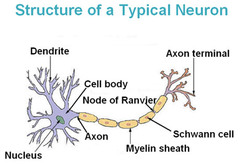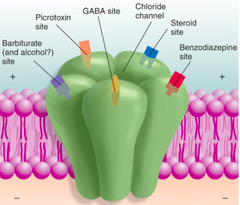Lecture 2: Microanatomy – Neurochemistry – Flashcards
Unlock all answers in this set
Unlock answersquestion
Describe ependymal cells.
answer
lining the ventricles and participate in the secretion os CSF because they are part of the CP too. They provide neural stem cells, when the brain is growing neural stem cells are pluripotent to differentiate into multiple cell types.
question
Describe Microglia.
answer
derived from monocyte, immune cells. Before the BBB formed they migrated into the developing neural tube and they differentiated differently. They stayed there as a population of immune cells that are protecting the NS from bacterial and viral infections. Remove damaged debris from old cells.
question
Describe olgidendrocytes.
answer
these cells wraps its foot processes and wrap around the axon, wrapping of myelinated cytoplasm. Every time it wraps around you get a myelin wrapping. Most of the cytoplasm disappears and you are left with the lipid membrane (insulation) affecting conductance. Only found in the CNS. Inhibit regeneration of damaged axons.
question
Describe schwaan cells.
answer
Cells in the peripheral nerves that do the same thing, they wrap around axons and myelinate peripheral nerves. These cells insulate the axons and also permit and encourage damaged axons regeneration of the axon, and you get return of function.
question
Describe Astrocytes.
answer
Migrate around an area of an injury and participate in inflimation.
question
Describe the radial glial cells.
answer
directs neuron migration, when new neurons are made they are born, they have to migrate to the places where they will end up in their final place they have to follow signals given off by special cells. They are radially in the neural tube from the centre out to where the pia matter is, they provide migrating neurons with direction and chemical signals. It acts as a scaffold.
question
What are the several functions of astrocytes?
answer
-Blood brain barrier -Maintence of extracellular electrolytes -Removal of excess K -Removal of neurotransmitters -There are chemicals that are released from the foot proccesses, and self regulate blood flow through vasodilation and vasoconstriction depending on activity.
question
How can neurons become easily excitable?
answer
he more active the nueron is the more extracellular potassium there is. They soak up potassium that is given off under periods of high activity to maintain the extracellular concentration. If this doesn't work you get epileptic symptoms (highly sensitive neurons
question
What are the main parts of the neuron?

answer
1) Soma ->Nucleus and nutritive 2)Dendrites ->Recieving structure 3) Terminal bouton ->W/ synaptic vesicles and the vesicle NTMs 4) Axon ->Where information travels ->Branching axons are called collateral branches and they give off a cloud of terminal branches and they all end wit ha terminal bouton. 5)Dendritic spine ->post synatpic swelling that a pre synaptic axon can synapses with
question
What are the main things responsible for membrane potentials?
answer
-Voltage-gates channels ->Na++ ->Ca++ -->K+ (delayed rectifyer) -Post-synaptic potentials -->EPSPs -->IPSPs -Transmitter-gated channels -AP conduction/myeliantion
question
What is the resting potential of the membrane?
answer
-65mV (heart, muscle and neuron are most excitable) excitability ~ 5mV/10mV
question
What are EPSPs and IPSPs?
answer
EPSP = helps approach threshold/ could potentially cause AP. More NTMs that bind, more excitation. IPSP = hyperpolarization
question
What is an example of transmitter-gated channels?
answer
-Cation versus anion flow -Neurotransmitter gated ion channels -Gabba opens chloride channels
question
How does myelination play a part in APs?
answer
0.2m/sec -> 10m/sec
question
What are the 3 neurotransmitter categories?
answer
1) Amines 2) Amino acids 3) Neuropeptides
question
What make up amines?
answer
-Quaternary amine: ACh -Monoamines like catecholamines and inodleamines
question
Describe the types of amines.
answer
-Quaternary amines are less numerous -Catecholamines are made up od dopamine, noradrenaline and adrenaline -Indoleamines are made up of 5-hydroxytryptamine (serotonin) and GABA
question
What are the types of neuropeptides?
answer
Neuropeptides are amino acids string together (5-10) -Opioid peptides -Other peptides
question
Describe opioid peptides
answer
: ENK important in pain management and pain mechanisms. Enkephalin
question
Describe other neuropeptides.
answer
i. Oxytocin released from pituitary gland and binds to the muscle of the uterus and causes contractions to start. ii. AVP causes constriction of blood vessels and raise blood pressure. Also called antidiuretic hormone. Released from the posterior pituitary (controlled by the nervous system/regulated) they are released from nerve terminals in the brain and involved in maternal behaviour and sexual reproduction behaviour. iii. Substance P is released by nerve terminals and involved in pain perception.
question
What are neuromodulators?
answer
b. Oxytocin, arginine vasopressin, substance P. as a group are considered to be a neuromodulator which is something that may not create and EPSP or IPSP but causes an effect that changes the excitability of the post synaptic structure neuron, it could make it more responsive to acetylcholine. Some have a duel role where they neuromodulator and they can also create an EPSp. Still packadge in vesicles and reslease from pre-synaptic to post-synaptic
question
What do receptor subtypes do?
answer
Provide huge diversity of responses
question
What are endogenous and exogenous ligands?
answer
Endogenous ligands are the ones released from the pre-synaptic terminals Exogenous bind to at least but more than often one (i.e. Ach receptors there are two major subcategories the nicotinic of muscle neurons and muscarinic are found in the brain they respond to Ach and got its name from a type of mushroom the nicotine in smoking will bind to it.
question
Does just the neurtransmitter alone tell us about the response that will occur?
answer
The neurotransmitters by themselves tell us no information about the response of the neurotransmitter you have to look at the receptors to understand what it will do. There are a diversity of receptors (i.e. serotonin has 12 receptors) and each subtype might cause a completely different response. These different subtypes allow for a diversity of responses Selective fore specific group of neurons
question
What kind binding is there?
answer
Agonist and antagonist bindings An agonist ties to a receptor site and causes a response whereas an antagonist works against the drug and blocks the response.
question
What are 2 major types of receptor signaling?
answer
1) Ionotropic 2) Metabotropic
question
Describe ionotropic signaling?
answer
-Ligan binding site -Ion channel -Fast reaction Ionotropic is very simple it means there is the neurotransmitter that binds to a specific part of the ion channel and there is a binding site for that ligand and it creates an opening of the ion channel and the ion flows in a particular direction, based on concentration gradients Neurotransmitters that open a simple ion channels and cause an ESP or ISP fast
question
Describe Metabotropic receptor signaling.
answer
-G protein couples -2nd messenger transduction -Sustained, augmented response -Altered ion channel opening -Induced intracellular signaling (Kinases) -Altered gene epression (receptor protein, enzymes NT synthesi, axon growth)
question
How are neutransmitters regualted?
answer
-Synthesis and storage
question
How are neurotransmitters synthesized?
answer
-Made in cell body and transported to terminal - Some are made in the nerve terminal biosythnesis takes place there
question
How are neurotransmitters moved and stored?
answer
-Packdged in synaptic vesicles - Stored in synaptic axon bouton, endoplasmic base vesicles
question
How are neurotransmitters released?
answer
-Action potential depolarization opens Ca2+ dependent fusion of vesicles to pre-synaptic membrane - Depolarizes pre synaptic membrane and active zone is where voltage dependent calcium channels are located -Exocytosis of NT
question
What kind of drugs intered with release of neurotransmittesr?
answer
-Boutlinum toxin -Local anesthetics -Resperine and others -Bacterial toxins can block SNARE fusion protein bindings
question
How are neurotransmitters released?
answer
-Exocytosis is veltage-dependent process -Calcium entry -Activation of SNARE apparatus -Fusion and release
question
Describe the activation of the SNARE apparatus.
answer
V-snares and T-snares form a snare complex (SNARE pin) , they attached the synaptic vesicle and pull it down and fuse it. When they are fused it makes a little opening. Fusion and exocytosis is a calciu mdependent process. 1) depolarization 2) calcium entry 3) calcium binding
question
What process is a target for many bacterial toxicity?
answer
-Neurotrasnmitterelease -Botox works by degrading part of the SNARE protein, part of the complex gets broken down because of the toxin
question
How do above toxins interfere with neurotransmitters?
answer
1) Botulinum clostridium botchulim blocks the release of neurotransmitter, prevents SNARE protein from exocytosis 2) Anesthetics Gives relief of pain because they work by preventing release by transmitters (some) 3) Respirine Originally identified as a anti-hypertension drug, some of the people who had this drug also ahd problems with schizophrenia, blocks the packaging of neurotransmitters into vesicles
question
What was the dicovery of freeze fracturing?
answer
-Heuser and Reese freeeze fractured membranes at the frog neuromuscular junction. they showed evidence for exocytosis of vesicles as viewed from inside the snypatic cleft
question
Describe freeze fracturing
answer
Freeze fracturing: but the muscle and axon on aluminum, they stimulate the axon (presynaptic axon) and it causes depolarization and the vesicles fuse with the membrane and before it drifts into the pre-synaptic cleft and they put the aluminium on top of liquid nitrogen and exactly the same time they stimulate the axon, the spring drops the hammer it squishes the nerve terminal onto the alumini and it freezes intstanly and it sperates the two leaves of the membrane.
question
What are the types of snares?
answer
1) V-SNARE -> Synaptobrevin 2) t-SNARE -> Syntaxin ->SNAP 25 3) Synaptotagmin is the Ca sensor
question
Describe the process of vesicle fusion.
answer
1) SNARE PIN complex is formed to bring besicles next to membrane at active zone 2) Calcium/receptor complex removes complexin protein from SNARE-PIN so vecile can be pulled into membrane for fusion (alpha helix) 3) Finally, the SNARES are unzipped and vesicles are retracted for re-filling and re-use
question
What is a secondary function of SNAP-25? How is it releated to disease/
answer
-SNAP-25 also puts brakes on Ca entry. Thi prevents over-release of NTs Snap-25 attaches itself to the calcium channel and prevents too much calcium from coming in. ADHS, schizophrenia, depression and epilepsy. All of these diseases haves some number of peoples that have mutations and SNAP-25 (under release or over release)
question
Describe the binding of NTs to post synaptic receptor GABAa.

answer
- They all have a binding site, when the neurotransmitter occupies that site it is going to cause a change that is going to open up that channel (this one is inhibitory that causes IPSP and there is an inward current of chloride ions) - Neurosteroid when it binds increases the effectiveness of the GABA called potentiating it. (even more chloride will come in) - Picrotoxin site - antagonist blocker site when it binds there it doesn't matter what is bound there it will prevent the channel from opening.
question
What are other exogenous ligands?
answer
Benzodiazepine, anxiolytic or Barbiturate (including in things like cough syrup) It increases GABA - Cobra venom, block the GABA receptor (exogenous ligand)
question
What are exogenous ligands?
answer
-Drugs can act as them -Compete with endogenous ligan -Mimic endogenous ligan -Modualte recetor fucntion (barbituate_
question
What are degradative enzymes>
answer
-Degradative enzymes in synpatic cleft -Shorten duration of NT response -As soon as the neurotransmitter binds wither an EPSP or IPSP occurs and these enzymes very quickly degrade them. Shorten duration of response, in addition there are some neurotransmitter protein
question
Describe transporter proteins.
answer
-Retrive NT for re-use in axon terminal -Pre-synaptic and glial cells -Cause the neurotransmiterr to be pumped back into the pre-synaptic terminal. Retrive old NT and allowed the be re-used
question
What inhibit re-uptake of monoamines?
answer
Cocaine and amphetamines -cause longer than normal NT function
question
What are autoreceptors?
answer
-NT binds to pre-synaptic autoreceptors to modulate (eg. stop) further release of NT -Has an aeefect of pre-synaptic membrane, regulates the snare pin apparatus of calcium channel activity regulating NT release.
question
What are the major NTs?
answer
1) ACh 2) Dopamine 3) Noreadrenaline 4) Serotonin (5-HT)
question
Wher edoes ACh bind?
answer
Neuromuscular junction (nicotinic receptors) nAChR Parasympathetic terminals (muscarininc receptors) mAchR
question
Why are the nucleus basalis and hippocampus important for ACh?
answer
-Basal forebrain projectiosn thorughout ctx and to hippocampus (memory fxn) Basal forebrain: there are neurons that amch Ach and the axons leave them and go all thorugh the cerebral cortex. This an area in alchemizers disease that is rapidly killed. Because the axons are so widewpread large parts of your cerebrum loses its Ach innervation
question
Describe the two pathways for dompamine.
answer
Mesostriatal pathways -Substantia niagra makes the dopamine and communiates with the striatum Meslimbocortical pathways, ventral tegmental area (VTA) the VTA is part of the emotional function and leave and go through the prefrontal cortex Small clusters of neurosn but their axons distrubte over widespread areas to have large and diverse effects
question
Why are catecholamines important?
answer
They are all closely related only tiny modifications change the chracteristic of the neurotransmitter -Enzymes invovled are clincally important if they are deregulated or mutated
question
Where are all catecholamines synthesized from?
answer
From the same amino acid (tyrosine)
question
Why do you have to give L-Dopa to people?
answer
-L-Dopa is givent to PD patients because DA an't cross BBB Reason you can't give a pill of dopamine is that is can't cross the BBB, and it goes into the brain and gets into the substantia niagra to boost dopamine.
question
What are the two areas that are important for noradrenaline?
answer
Locus coreuleus lateral tegmental area
question
Describe the locus coreuleus.
answer
-Diffuse projections to ctx -Responses include: cortical activation, mood, sexual responses -Project to lateral tegmental area which is important for sleep/wake and cerebral function
question
What makes noradrenaline?
answer
-Locus coeruleus -Lateral tegmental area
question
What is cortical activation?
answer
Corticol acitvation is part of the response, the change in the EEG from a quite resting mode to an activated mode, random little electrical signals in the cortex.
question
How is the reticular formation related to the lateral tegmental area?
answer
Lateral tegmental area goes from midbrain down to the medulla and the ARAS is part of the reticular formation
question
What coordinates sexual responsiveness?
answer
NA together with the aparasympthetic NS coordinates are sexual responsiveness, used during the orgasm phase of sexual activity
question
Where is serotonin made?
answer
The origin of the projectos come from a cluster of neurons called the raphe (microscopically small bundles of cell bodies that make seretonin) -Has diffuse cortical projections
question
What is the function of serotonin.
answer
There are specific drugs to enhance the production of serotonin and increase transmission = antidepressant Some go down to the spinal cord, and involved in the mechanism for pain control, prevents pain from going through
question
How many receptor subtypes does serotonin have?
answer
>19 Has more receptor subtypes than any other neurotransmitter
question
Describe the functions of Glutamate.
answer
-Major excitatory NT -Can cause excitoxicity/cell death -Important in learnin and memory
question
Describe excitotoxicity.
answer
In certain conditions glutamate can be overwhelming to a neuron and cause excitotoxicity and cause death of the cell that receives this flood of glutamate. This is because glutamate can cause calcium entry depending on the type of receptor and if it is a massive amount of glutamate calcium entry can activate calcium dependent proteases (excitotoxicity)
question
Describe the functions of GABA.
answer
Gamma amino butyric acid -Major inhibtory NT -GABA receptors bind to modulatory drugs to alter the inhibitory effects of GABA in the brain



